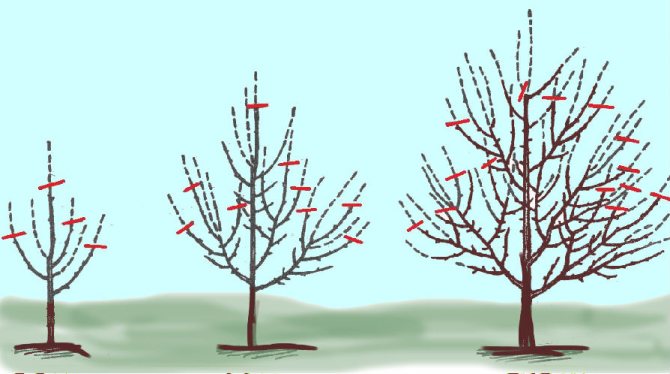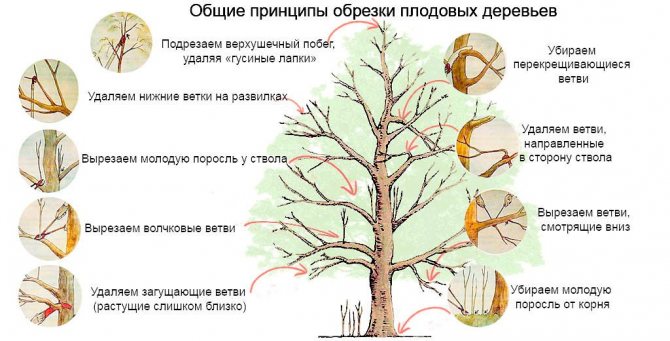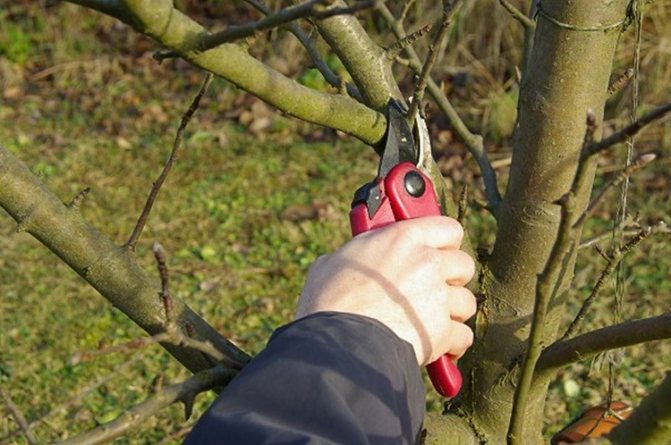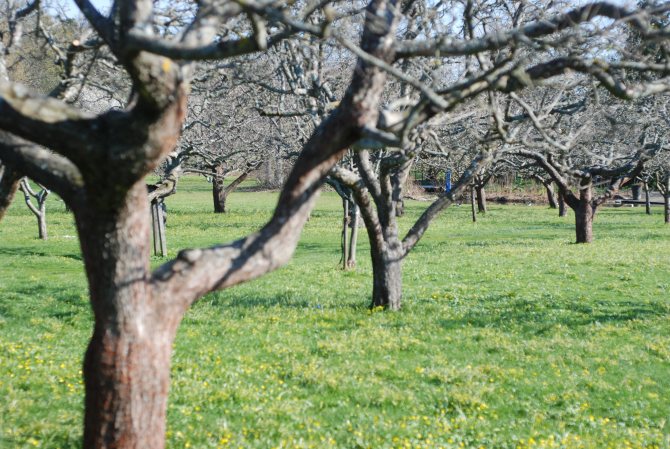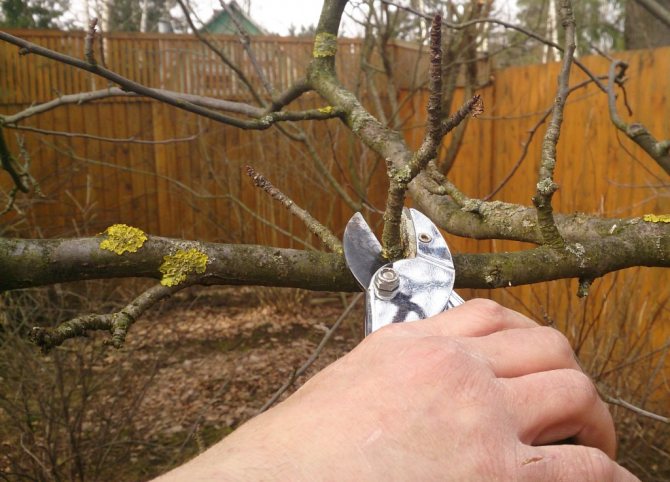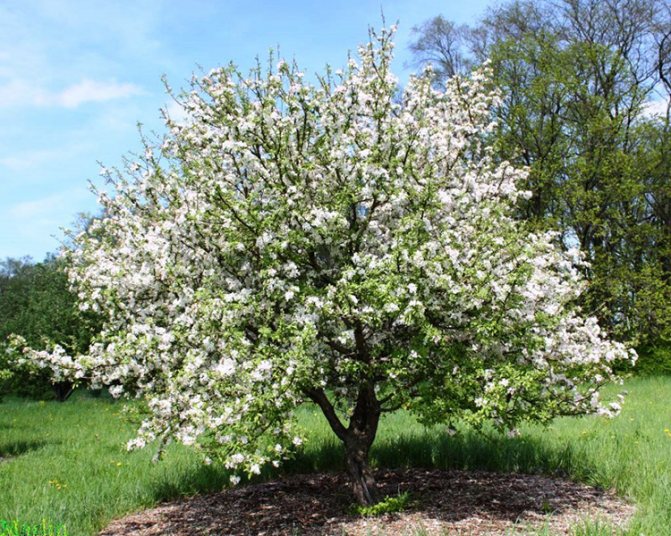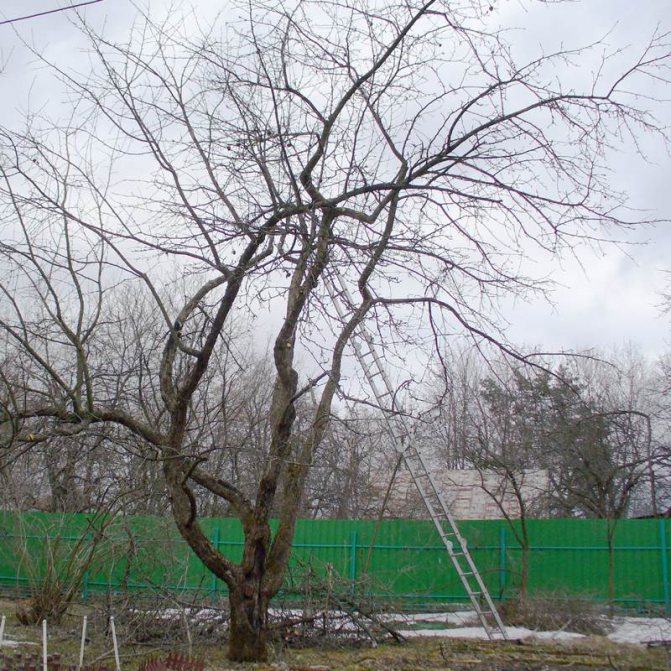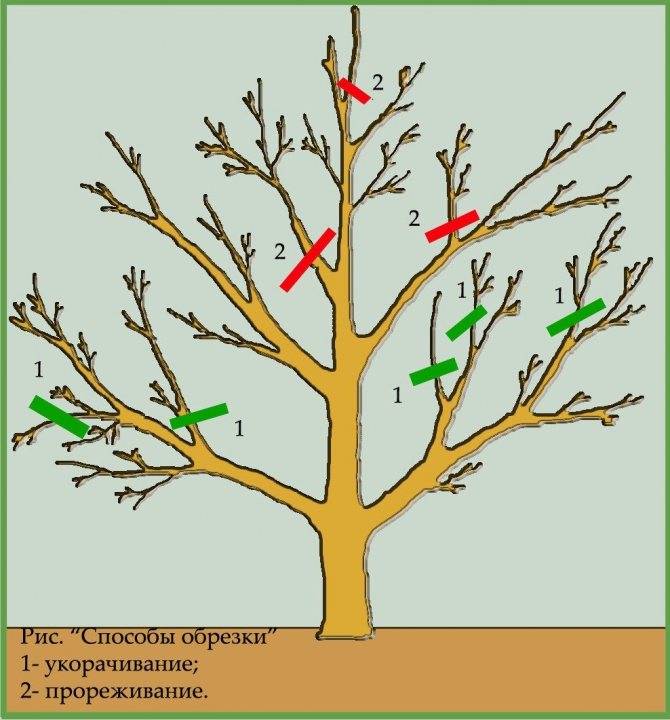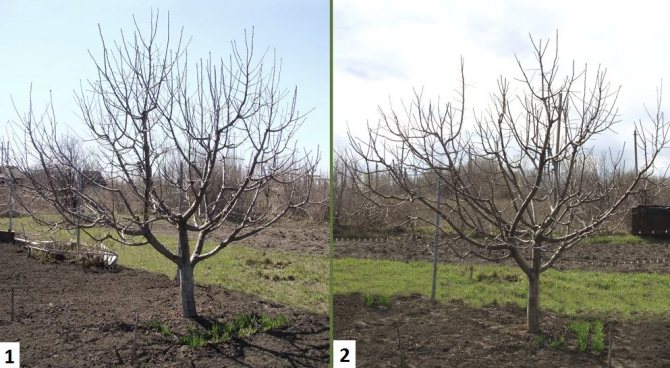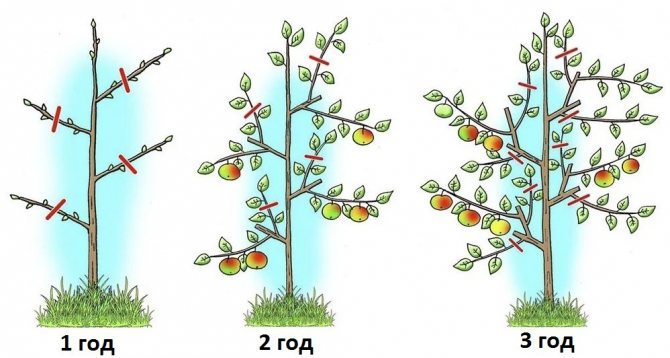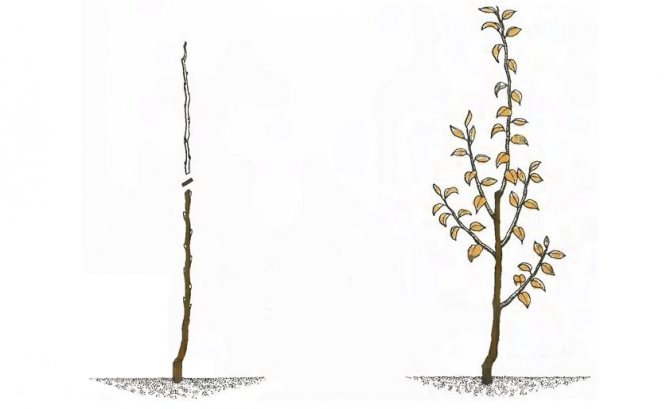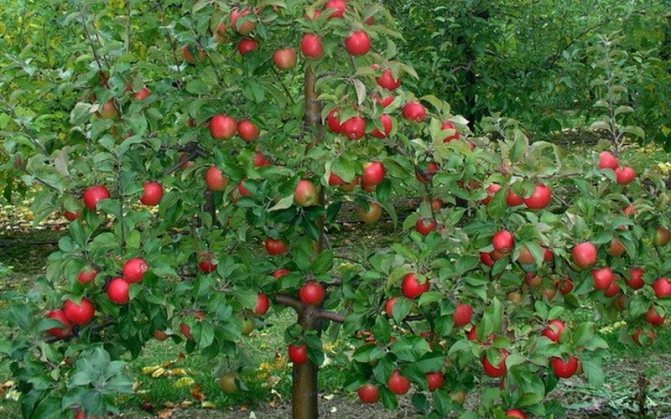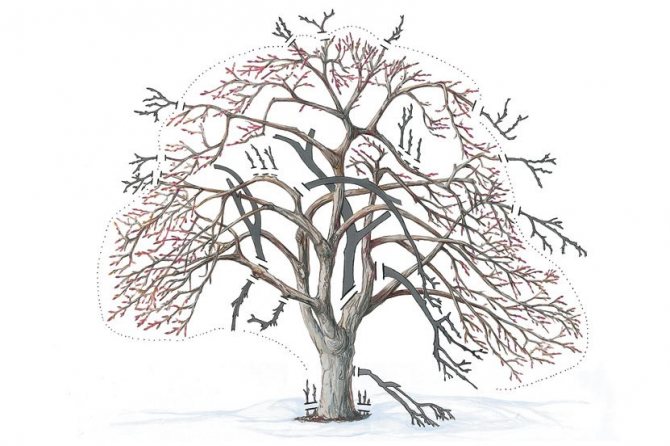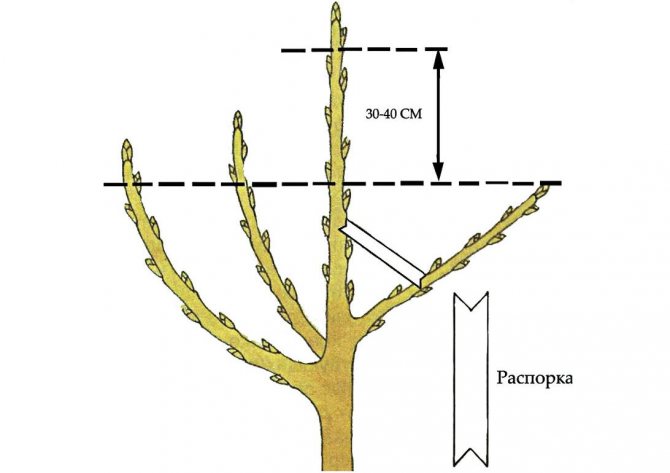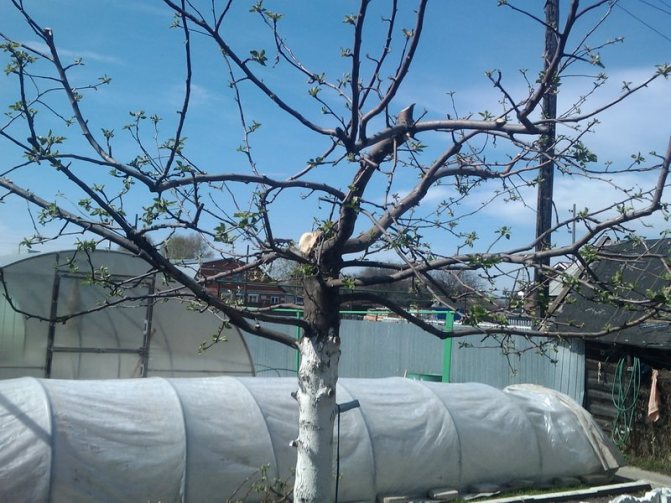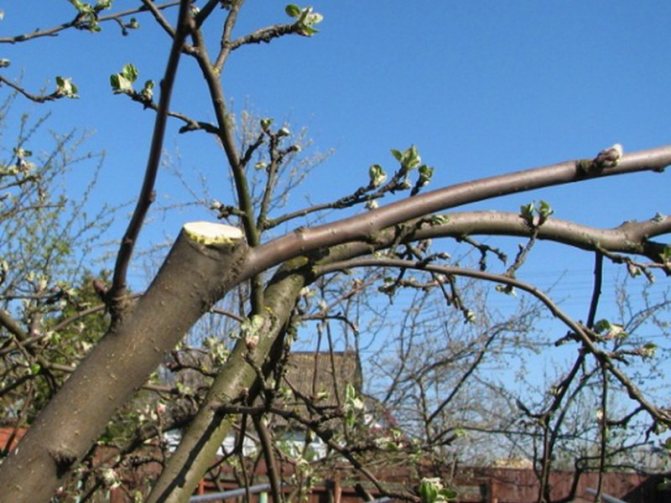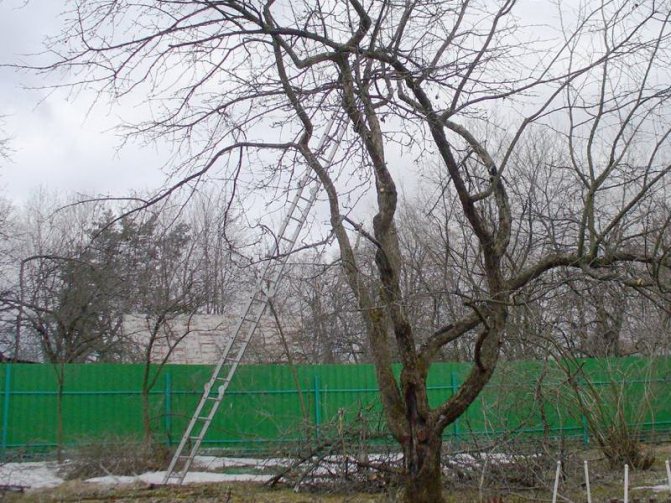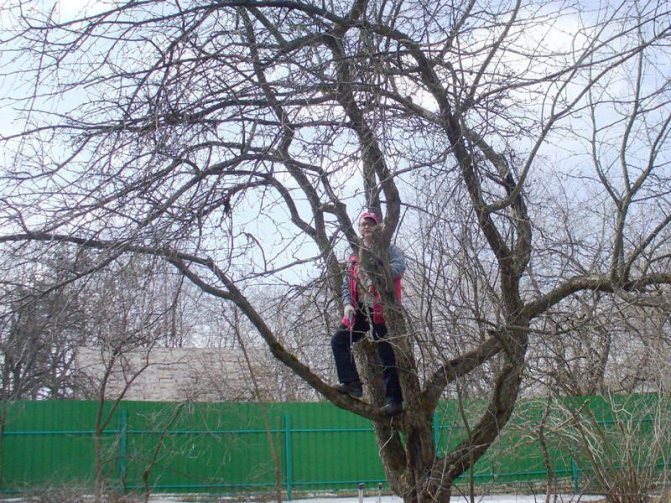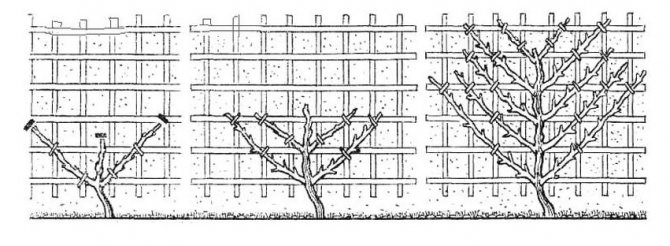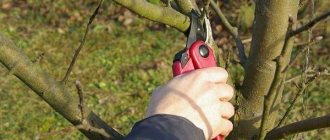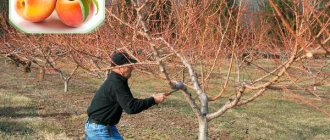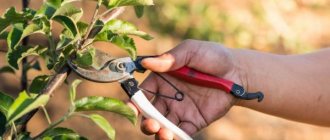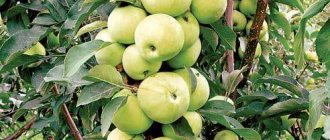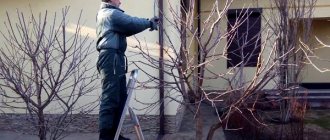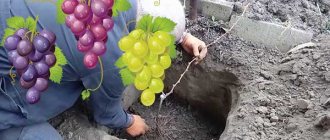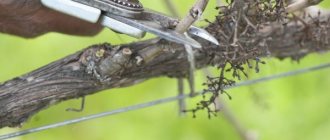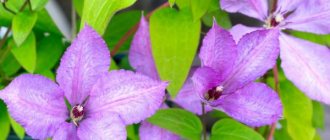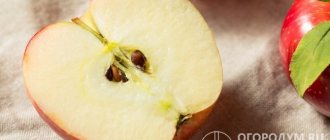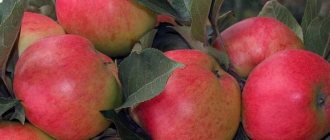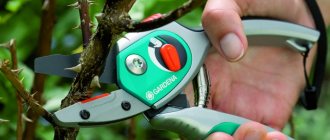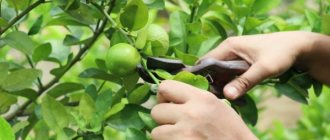The apple tree is one of the most productive crops, which, with proper care, will yield good yields every year. How beautiful a blooming apple orchard looks in springtime and a garden that begins to bear fruit from mid-summer, right up to the first frost. All varieties of apple trees have their own definite period of fruiting, taste, smell, color, degree of hardness and juiciness. The editorial staff of the Agronom.guru portal will help novice gardeners navigate the question of how to properly carry out spring and autumn pruning of apple trees. Also, the article will provide photos and video tutorials for beginners.
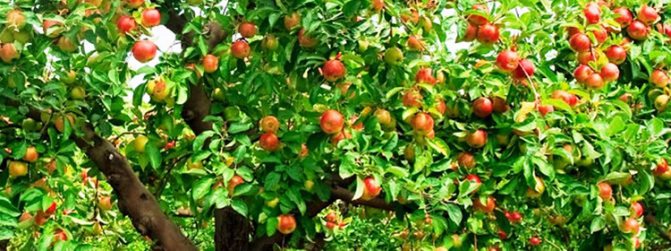
Apple tree is a true patriarch among fruit trees
Pruning apple trees in spring for beginners: the most suitable season
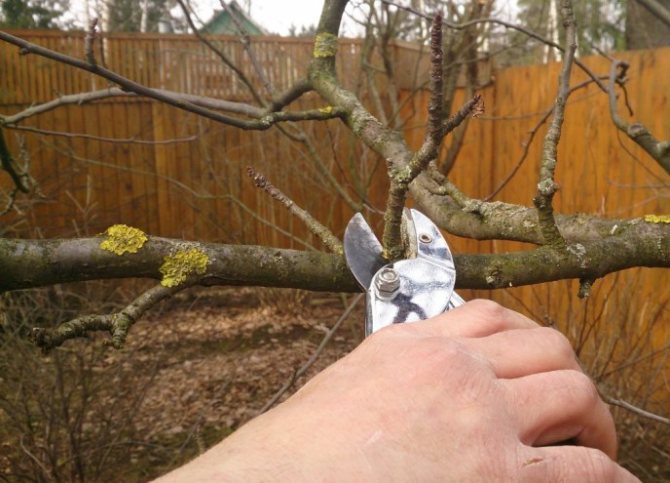

Apple tree pruning
Most gardeners cannot decide at what time of the year it is better to prune apple trees - autumn or spring. So, both spring and autumn are equally suitable for performing such a procedure. The most important thing is that the tree is at a dormant stage.
It should be noted that you do not need to eliminate many branches at once, you need to do this gradually. Otherwise, this will cause an active growth of young branches, which will entail a thickening of the crown and a decrease in the amount of harvest.
Pruning apple trees: pruning timing
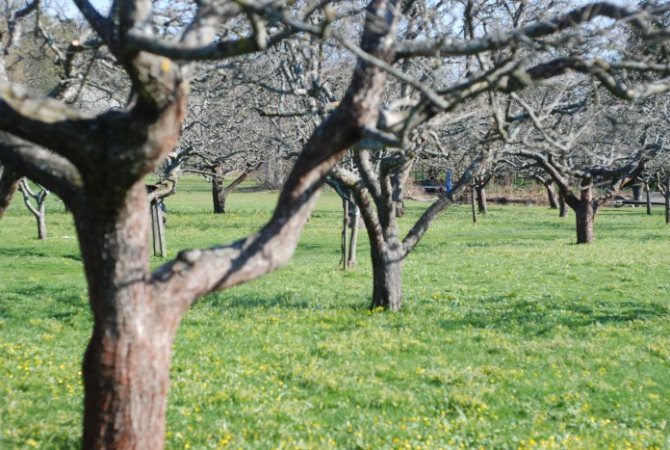

Apple trees in early spring
You need to know when pruning of apple trees is allowed in the spring. This procedure should be performed before the intensive movement of sap in the shoots begins (a sign of this is the intensive emergence of young shoots and buds).
What is the time period for spring pruning of apple trees? The most suitable - from the end of March to the beginning of April, but only if a sharp drop in temperature is not expected. The choice of this period is due to the abundance of spring moisture and beneficial substances, as well as solar activity. These factors allow the apple tree not to spend many resources on recovery, but to direct them to the development of buds and shoots.
Typical mistakes
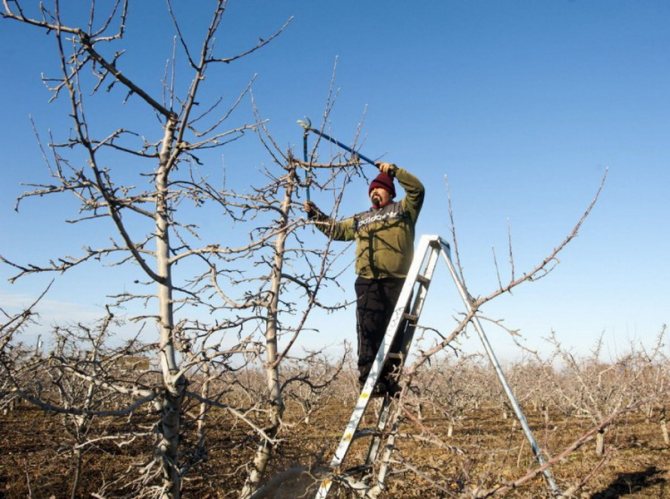

Novice gardeners often do not know all the intricacies of the workflow. Unknowingly, they harm trees or form the crown incorrectly, due to which fruiting worsens. To eliminate such a problem, deal with the most common mistakes:
- The working tool is not disinfected. As a result, the disease can be transferred from one infected plant to others.
- Poor cutting surface quality. If the hacksaw or pruning shears are blunt, they will tear the wood fibers, impairing their healing.
- Incorrect cutting of thick branches. It is always necessary to start from the bottom so that the bark does not rip off when it falls.
- Too far or too close location of the saw cut to the trunk. In the first case, a stump remains, from which tops then constantly grow. In the second, the bark on the trunk is damaged.
It is also important to immediately pick up a scheme, do everything according to it, and not just remove some branches, but leave some. Make sure that the length of the shoots is approximately the same, and that they themselves do not stretch very much upward, since because of this, the likelihood of damage under the weight of the fruit greatly increases.
Pruning the apple tree in spring is much preferable to pruning it in autumn.To carry out the work, choose the right time, prepare the necessary tools and means for processing saw cuts. Consider the age and type of plant in order to find the optimal formation option Try to carry out work without missing a single season.
Pruning apple trees in spring for beginners: rules and tips
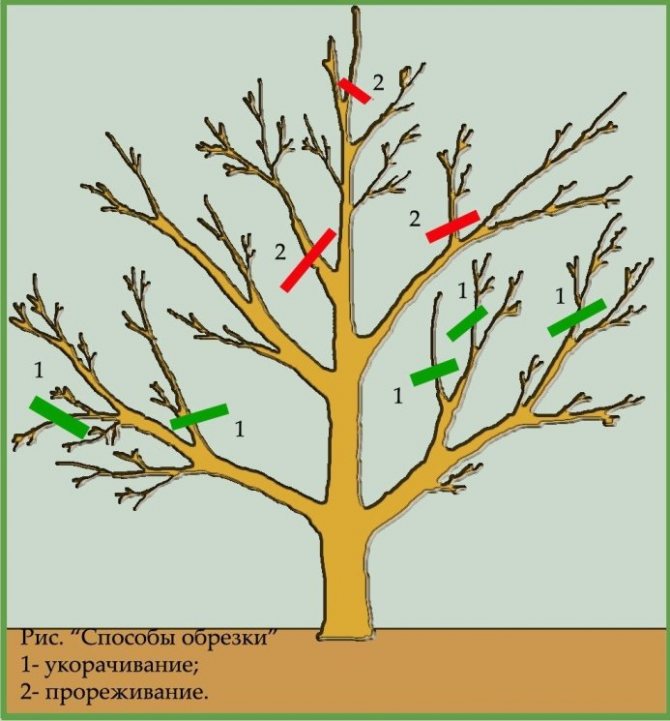

There are rules for pruning apple trees in the spring, the observance of which prevents the commission of some mistakes. The procedure for spring pruning of apple trees is to shorten and remove the shoots.
For this purpose, the crown is cleared of: • Each shoot, whose growth is directed to the middle; • Interference preventing the growth of main branches; • Weakened branches that do not bear fruit; • Dry and injured branches.
To simplify the collection of fruits, it is necessary to shorten the tops of the lateral branches. This activity gives you the opportunity to easily reach every branch of the tree.
There are also rules for all types of pruning apple trees in the spring: • The tree should be looked after regularly; • Branches growing in a vertical direction must be eliminated; • All diseased shoots must be eliminated once a year; • Particular attention should be paid to improving the illumination of the center of the apple tree; • Large branches should be cut at a 45 degree angle; • Minor shoots (up to 4 cm in diameter) must be cut under the bud.
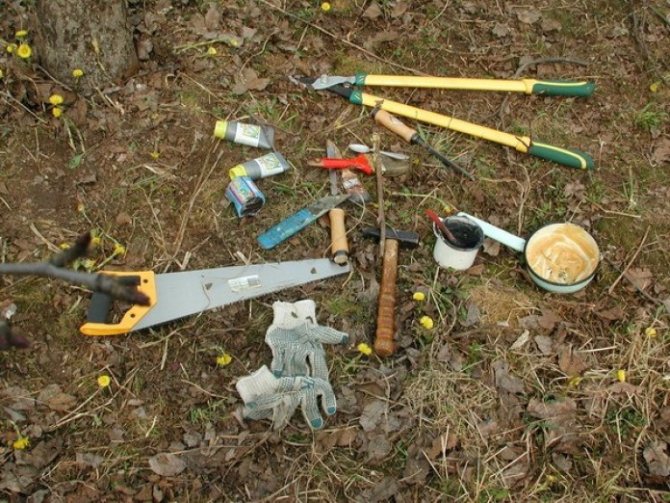

Apple pruning tools
Use only clean, sharpened and disinfected instruments that show no signs of corrosion. Otherwise, rotting of the branch may begin, and in the future - of the whole tree.
Useful videos
See the detailed story of an experienced agronomist about pruning young apple trees:
Learn how to prune a young apple tree in spring: videos and tips.
For this purpose, the first pruning is carried out. It should be carried out in such a way as to immediately outline the appearance of the future crown. Do not allow any deviations in its structure to develop or correct in a timely manner, without waiting for the apple tree to acquire serious dimensions.
TIP! On a young tree, a part of the trunk is cut off so that at least two buds remain on the remaining part.
Pruning a young apple tree in summer
Young apple trees need summer pruning, as well as watering and feeding.
By removing the branches, the crown of the tree is formed, which will allow you to get a large amount of the best quality harvest.
If you do not carry out the summer pruning of young apple trees, it will run wild. And the fruits will become small and tasteless.
To provide leaves and fruits with the necessary amount of sunlight, as well as in the future a convenient ripening period, it is important to know exactly how to properly cut a young apple tree.
The main task in the process of summer pruning of young apple trees is crown thinning to provide the apple tree with full ventilation and lighting. This is necessary in order to achieve a bountiful and high quality harvest.
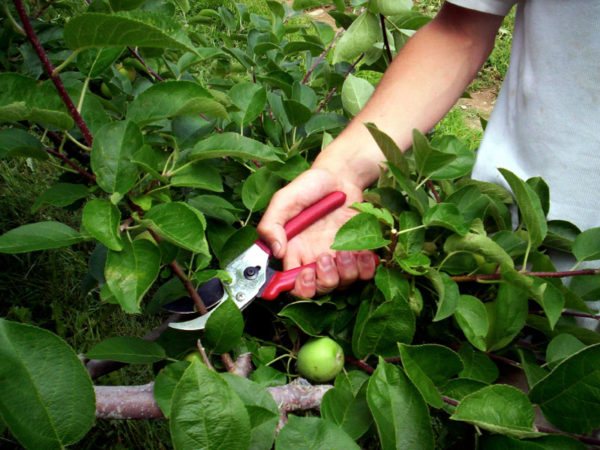

Summer pruning.
Before proceeding with pruning, you need to determine what is required at the moment from this process. This affects terms of implementation and on the scheme of work.
Not all gardeners do summer pruning. But you shouldn't neglect it. At this time, all the trees in the garden are completely foliated and you can immediately identify which branch is causing the shading. They need to be either shortened or completely removed.
It is interesting! In summer, the apple tree forms new shoots. To keep them from growing, they are pinched.
Many gardeners practice breaking branchesthat hinder development.
When doing summer pruning, the use of tools is optional. A top growing vertically thickens the crown, it must be broken off without much pity.
It should be remembered: ignoring pruning in the summer and not removing young shoots, after a few years you will have to trim full branchessince fruiting depends on sufficient air and sunlight.
Pruning young apple trees in the fall: scheme
In August, juice is still fully circulating in the apple tree. But the autumn months (September, October, November) are completely suitable for this process. Read more about the autumn pruning of apple trees at the link.
Adhering to certain rules, pruning of branches occurs after the growth of the shoots has stopped. This phase can be determined along the formed apical shoot bud. At this time, nutrients will completely stop the outflow from the leaves to the root part.
The optimal month for pruning is October. The leaves at this time do not fall yet, they only change their color. Until the cold weather sets in, the weather is dry and warm, the wounds on the trees will heal faster.
Cut off damaged, dry branches. Using garden var or oil paint, cover up the place of the cut.
Pruning for the formation of the crown of young apple trees is not recommended. Shortened annual growths and branches may freeze slightly.
When forming a crown, strong pruning should not be carried out. Annual growths are enriched with nutrients, and a young apple tree can lose them. This will weaken the growth process, worsen the ovary, which will lead to shedding of the fruit.
This process should be carried out in dry cloudy weather, if desired, choosing a suitable day according to the lunar calendar.
Pruning apple trees in spring for beginners: varieties
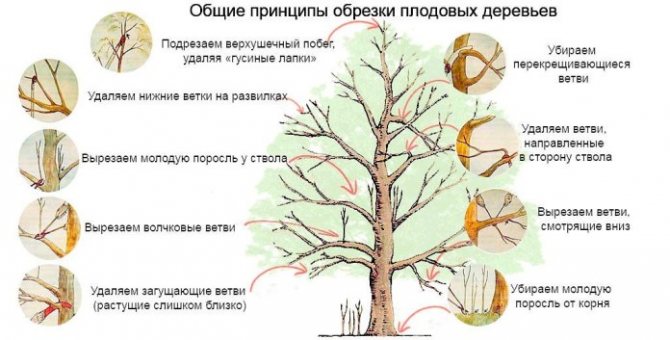

There are several varieties of pruning apple trees in spring, differing in the purpose of implementation and the age of the tree: formation, rejuvenation and sanitary. In addition, the instructions and timing for pruning young and old trees differ.
Spring pruning of apple trees of the sanitary variety is carried out in order to clear the crown of branches that were damaged in winter. This procedure is carried out if necessary, and regardless of the age of the tree.
Pruning old apple trees
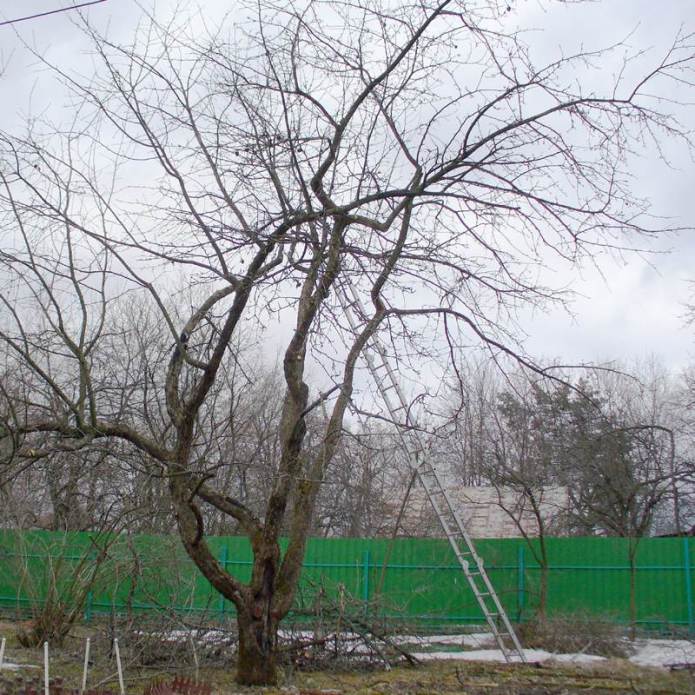

Preparing to prune an old apple tree
Spring rejuvenating pruning performed on old apple trees can increase the tree's lifespan. There are rules for pruning old apple trees to avoid mistakes when performing this procedure.
First, you need to make sure that the branches of the chosen tree are in good health and strength, since a diseased apple tree can hardly be restored even with the correct procedure. Pruning should be done before buds begin to appear to ensure an optimal view of the crown.
Prepare the tools you need in advance: ladder, saw and pruning shears.
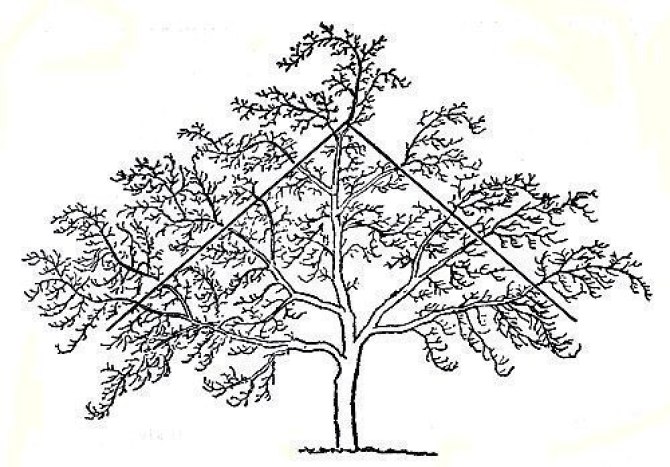

Scheme of pruning an old apple tree
The process of pruning old apple trees: • Prune the main branch and all branches by a third to ensure that the lower branches are illuminated; • Eliminate every young shoot growing at the base of the apple tree and from the trunk; • Cut out each branch that grows "down"; • In case of close placement, a stronger branch should be left and the other should be eliminated; • Cut off the lower shoots on the branches; • Branches whose growth is directed towards the middle of the crown must be removed.
Such pruning should be carried out according to this instruction for three years, after which positive changes and a strong increase in the quality of the crop will be visible. When you have finished trimming the old apple tree, cover each stump with garden varnish or plasticine. Cover the larger ones with plastic over the top of the putty to help the apple tree transfer stress more easily. With the onset of autumn, this shelter must be removed so that the tree is strengthened before the cold begins.
It is worth noting that you do not need to eliminate a huge number of branches at once. Their number should be equal to about a third of all shoots. Otherwise, culture recovery after the procedure may not occur.
Pruning young apple trees
In the first years after planting an apple tree, its crown is formed. So young trees need to be given special attention, since it will be difficult to change or correct anything in the future.
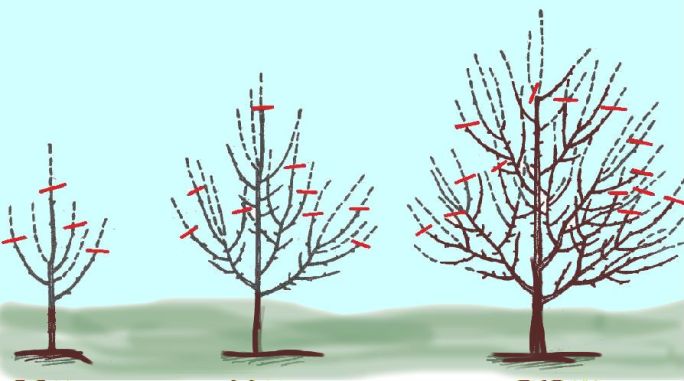

Pruning scheme for young apple trees
Correct spring pruning of young apple trees is also of great importance for the full-fledged formation of the root system. This is due to the fact that when transplanted to a permanent place, the tree is under stress, and in order for the root to provide nutrition to the crown, the apple tree should be pruned in time. Otherwise, the culture will be sick for a long time and eventually die.
A one year old tree is pruned immediately after planting. The procedure consists in cutting the top of the tree at a height of 100 cm from the soil surface (if there are no branches from the trunk) or in shortening to a height of 60-80 cm (if there are still branches), while the lateral shoots must be cut to a length of 40 cm. that grow at an acute angle should be removed as they very often break off under the weight of the crop. Each branch that joins the trunk at a right angle should be left, having previously cut off to three to five buds.
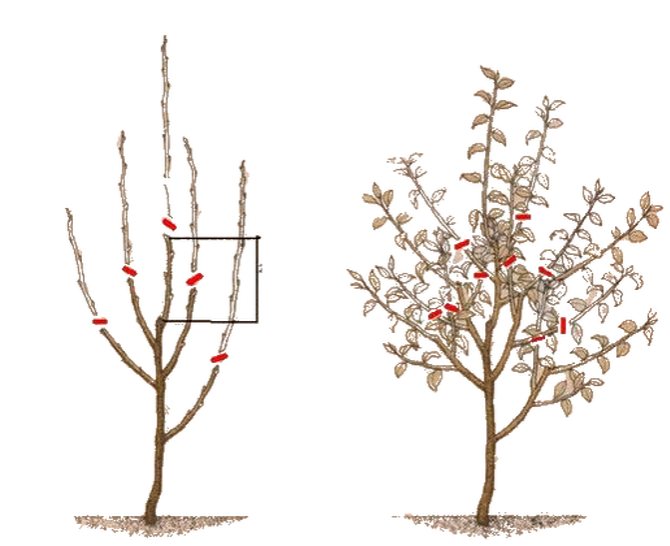

Pruning a two-year-old apple tree
A two-year-old tree already has a number of lateral branches.
The procedure for pruning two-year-old apple trees is carried out in accordance with the following instructions: we leave 3-5 strong shoots, differing in a convenient placement angle, and remove the rest.
Namely:
- Cut the main trunk. It should exceed the rest of the branches by four buds;
- Slice all other branches. The lower ones should be 30 cm longer than the upper ones.
By following the steps above, you will have a two-year-old seedling with the correct rounded crown.
For seedlings 3 and 4 years old, active crown formation continues, so you should be careful when cutting such apple trees. In order to prevent the negative impact of the event on the quality of the crop, branches should be cut to a minimum. In this case, you should not allow the bifurcation of the trunk. In addition, shoots should be cut out, the growth of which is directed towards the middle of the crown.
Post-pruning activities
It is important to remember that immediately after the procedure, fresh cuts must be covered with garden varnish, or special mastic for garden work. If nothing suitable is available, you can use an oil paint with the addition of a fungicide (copper sulfate). Thus, the sap will not flow out, and the tree will recover faster.
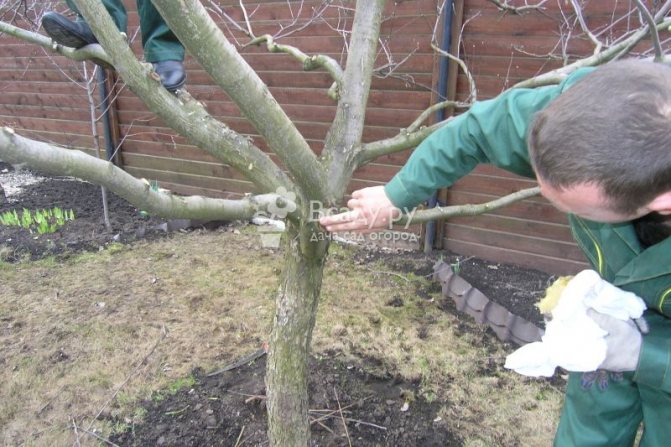

Processing a fresh cut on an apple tree
Such processing helps protect the tree from various infections and diseases that can penetrate through a fresh cut. One infected branch can kill the entire tree.
Crop an apple tree video: preparing a tool for processing slices
Pruning bonsai
Pruning dwarf apple trees is different in that it must be done as soon as possible. First of all, you need to carry out sanitary removal of each broken and weakened branch. This procedure is carried out immediately after the apple tree is planted in a permanent place.
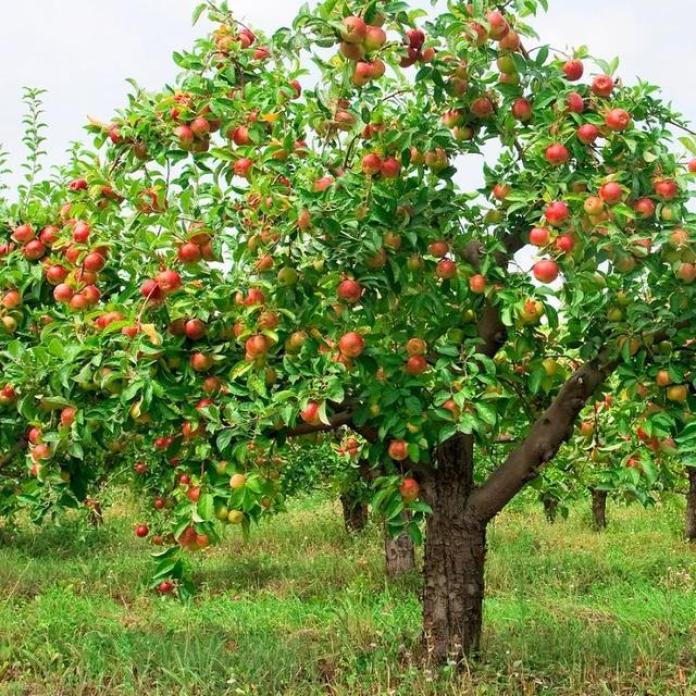

Dwarf medium-grade apple tree
In the first year, the main shoot is shortened at a height of 50 cm.Thanks to this, by the end of the season, you will receive at least four strong shoots. Among them, the upper one growing in a vertical direction will become a conductor. In the second spring, the upper and other extreme shoots are cut off at a height of 20 cm from the base. Shoots not needed for the development of the main skeleton are cut at the level of the third leaf. The same actions are carried out in subsequent years. When the apple tree reaches the required height, it becomes necessary to annually remove a new growth of the conductor.The extreme shoots must be removed after reaching their length of the 45-50 cm mark.
Pruning columnar apple trees
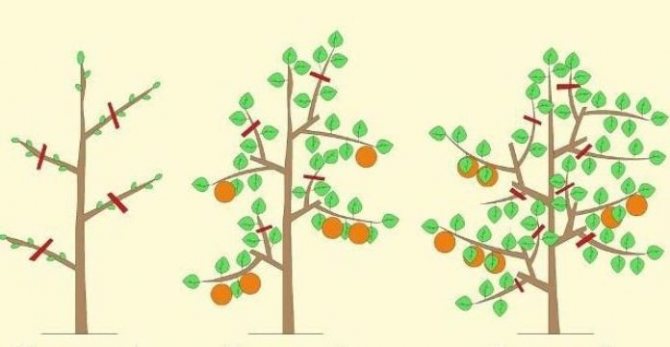

Scheme for pruning columnar apple trees
Today, you can often see columnar apple trees, the popularity of which is growing every year. The procedure for pruning columnar apple trees consists of several stages.
The process of pruning columnar apple trees: • In the first year after planting, the main stem must be shortened to a height of 1 m. Many horticulturists advise against doing this, but the summit is very sensitive to cold temperatures during the winter and usually freezes. As a result, by the time spring comes, several upper shoots appear, of which the strongest is cut off, and the rest are cut off above the second or third bud; • In the second year, it is required to shorten each lateral branch with a length of at least 30 cm. The apical shoot should not be touched at the same time; • In the third year, it is necessary to shorten the apical shoot to a length of 45 cm from the main trunk. But the side branches must be cut by 40 cm; • In the fourth year, tree thinning is performed, eliminating weakened and last year's shoots; • In the fifth year, the growth of the apical shoot is stopped at a height of 3 m from the soil surface. Starting from the sixth year, only sanitary pruning of columnar apple trees should be performed to stimulate the growth of young shoots.
Care after the procedure
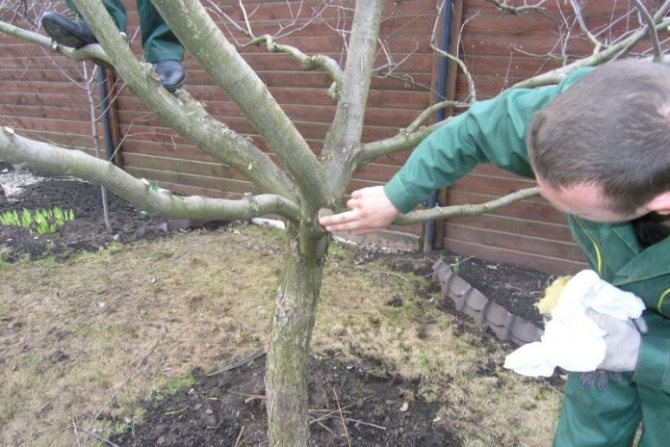

Processing the apple tree after pruning
To ease the stress transfer of the tree after the spring pruning event, it should be properly cared for. To this end, a list of procedures is carried out to facilitate the adaptation of the apple tree and its growth.
For this you need:
• First of all, it is necessary to carry out the processing of each zone subjected to cutting, with a garden varnish or with a working composition of copper sulphate in order to prevent the juice from flowing out; • Removal of weeds and loosening of the area around the trunk of the young apple tree should be constantly carried out to provide air access to the roots; • In order to avoid excessive evaporation of moisture from the soil, it is required to carry out mulching with rotted manure with a layer of 3 cm; • During the growing season, the tree should be treated with a fungicide and an insecticide to prevent the formation of fungal diseases and the emergence of pests that can weaken the apple tree.
Spring pruning features
Annual apple tree
An annual apple tree seedling has no branches. Pruning is necessary to restore balance between the roots and the trunk. It is recommended to remove anything above one meter. Side strong shoots will appear, from which the crown will form. If there are side shoots, you need to remove those that are lower than 70 cm.
Further pruning takes place according to a strictly defined scheme.
- Shoots are completely cut off, at an acute angle from the trunk.
- A branch at an angle of 90 degrees is removed up to 3 buds. In the future, it will turn into a future crown, so it is not cut off entirely.
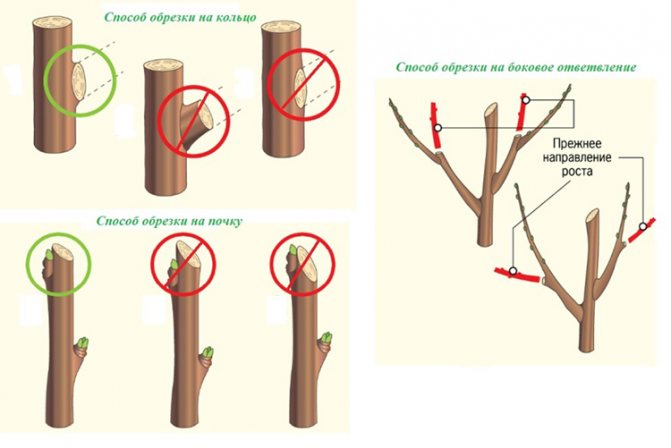

Biennial apple tree
A two-year-old apple seedling is already starting to branch. The main task from the bud at the top is to grow a strong main shoot, which is a continuation of the main one. It is recommended to tie it up, then the main trunk will be even.
Excess shoots can be removed, or gently bent and fixed. Branches extending from the trunk at an angle of less than 45 degrees are not skeletal. They can be either completely cut out or folded back with spacers. This can be done easily. The fixation must be strong, but at the same time mobile, so that the branches do not break with a strong wind.
They are removed for the winter, and, if necessary, put back in the spring season. Branches growing between the main tiers can also be folded back and shortened. They will bear fruit faster. And in the future they are removed.
Side branches are left at a young tree. Superfluous ones are not immediately cut off. At first they are only shortened, and after two years they are completely removed.By that time, a young, developing apple tree will already have a sufficient number of other branches.
The shoots from which the skeletal branches will grow must be shortened. This is necessary to stimulate branching. In the future, the lower branches will become the longest, so they are pruned more. Strong shoots will grow from them. Fruits will form on small, thin branches. They are left behind. They will be useful for the future harvest.


Five meters is the ideal height of the apple tree, if it is higher, then the branches practically do not receive the necessary nutrients. There are varieties in which the fruits are exclusively on the peripheral branches, which leads to their breaking off. Therefore, you need to prune them regularly. If the apple tree does not bear fruit for a long time, the forming pruning is stopped.
Adult and old apple tree
The tree is considered an adult at five years old. It has practically formed. Further, its growth should be limited. To do this, cut off the central conductor. The formation of the crown is carried out every two years. But dried up and excess shoots and branches are still cut off every year.
When an apple tree is more than twenty years old, it is considered old. If fruiting is low, then it should be rejuvenated. A third of all branches and shoots are cut out. The apple tree will begin to bloom and bear fruit more actively.
Spring pruning for beginners: common mistakes
Even gardeners with extensive experience make mistakes when pruning apple trees in spring that affect the growth and formation of the apple tree. So let's take a look at them ahead of time:
- Leaving the stumps. Do not leave them, it is necessary to carry out an annular cut (on the fold of the bark forming an annular influx), which will allow the tree to tighten the wound itself;
- Irregular shortening of the apical conductor on a young apple tree. This entails the appearance of several upper shoots, weakening the lateral ones;
- Using a tool that is not prepared for the procedure. It is allowed to carry out the event only with a sharpened and disinfected instrument. Otherwise, when pruning, seizures in the bark may occur, preventing the wound from being healed.
The above mistakes are often made by both beginners and seasoned gardeners. Making these mistakes will make the procedure useless, if not harmful.
Correct formation of the crown of dwarf apple trees
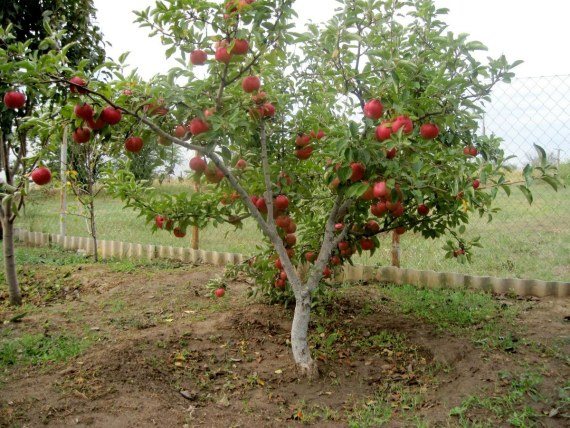

Dwarf apple trees also need shaping, like trees with a standard crown:
- In the first spring, the trunk of the apple tree is pruned, leaving it at a level of 50 cm. By the end of summer, several strong branches will appear on the trunk.
- In a two-year-old apple tree, the central conductor is pruned in the spring and the lateral shoots growing down are completely cut out.
- In the third year of life, the central branch is shortened by 5-10 cm, the lateral shoots must be shortened by 20 cm.
- In mature trees, lateral branches are annually pruned so that their length does not exceed 0.5 m.
The height of the apple tree is regulated by pruning the guide. Dwarf varieties should not be higher than 2-2.5 m.
Pros and cons
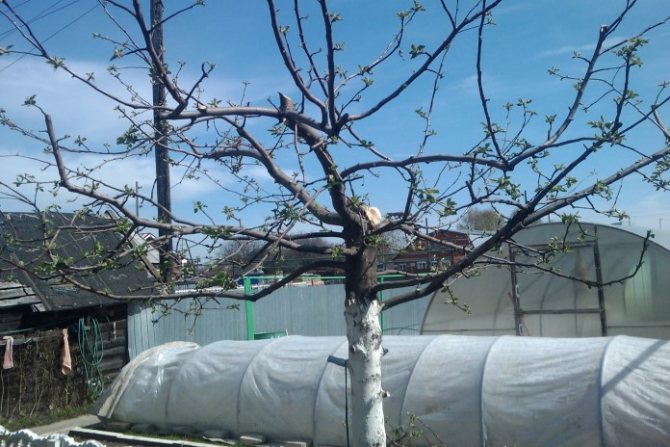

Pruning the tree in spring gives the apple tree a beautiful appearance, makes the trunk more robust, and strengthens the branches. If you do not engage in pruning or carry it out without observing the rules, then this can lead to deformation of the crown and breakage of branches under the weight of the formed fruits.
The main advantages of spring pruning of apple trees:
• Possibility of optimal crown formation, elimination of dry and injured branches; • Increase of light permeability; • Serves as a preventive measure to prevent the development of diseases; • Allows to reduce the number of pest larvae; • Provides the opportunity to obtain a large number of fruiting branches; • Rejuvenation of old and a significant increase in the strength of young branches.
The main disadvantage of pruning apple trees: pruning timing is very difficult to calculate accurately.
You have to focus on the current weather and your feelings.Spring pruning is essential for apple tree formation. With its help, you can improve the quality of the fruit. Also, this procedure is a guarantee of the long life of the apple tree.
Instruments
Spring pruning is carried out using professional tools that will provide the most gentle cut for the tree and make the process comfortable for the gardener. An important point that beginners should pay attention to: the components should not be rusty and clean.
Before starting work, you should treat the tools with an antiseptic (for example, alcohol). Disinfection is carried out to avoid infection with fungal infections during the transition to each subsequent tree.
Secateurs
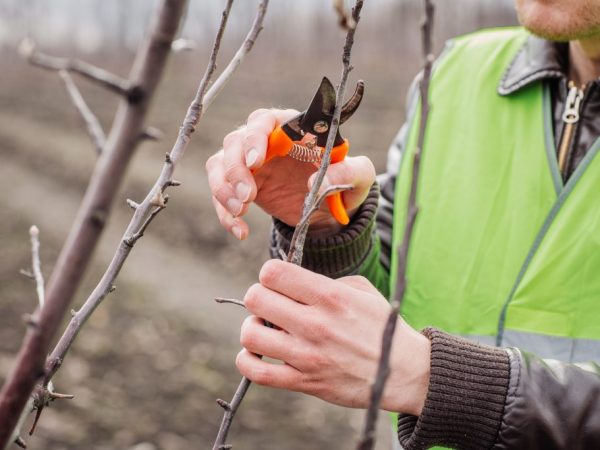

Choosing a convenient tool
The main tool in a fruit orchard is a pruner. It helps to provide maintenance of the garden, and the comfort of the gardener depends on its quality during work. There are two types of this device:
- with an anvil - this is a more convenient version of the tool, the blade of which works like an ax and cuts off strong, dried branches;
- bypass - works like a scissor and is suitable for removing thin shoots and trimming the trunk of annual apple trees. In this case, the supporting (lower and concave) blade should be at the bottom, and the working blade should be on the side of the main branch.
Choose pruning shears with blades made from hardened or high carbon chrome plated steel. To keep the hand from getting tired, the tool is equipped with a ratchet mechanism and a belt-type spring with return. Convenience is provided by a polyimide or fiberglass handle.
Garden saw
The saw helps to remove those branches that are too large for the pruner to remove. It is important to remember that a "hacksaw for wood" is designed to work with "dead" wood, and it will inflict severe injuries on living tissues, which will complicate the recovery process.
The saw, which is designed for cutting branches, has a slight bend for practicality and tapers towards the end. It easily works in two directions, without clogging up the sawdust obtained in the process.
Knife
A garden knife made of quality material will help get rid of various irregularities and burrs, making the cut smoother.
Lopper
A bar lopper can be used for taller apple trees. With its help, it is possible to eliminate the most difficult to reach branches. The principle of operation of the tool is the same as that of the pruner, with only one difference - the telescopic handles are long and must be held with both hands.

